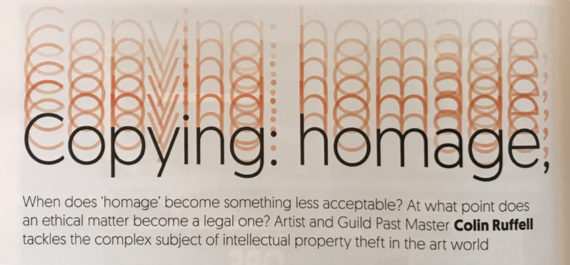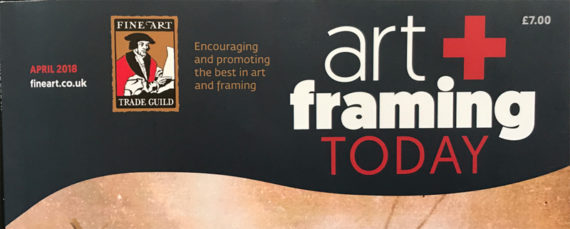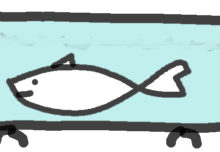from ‘Art and Framing Today’ magazine April 2018
Artist and Guild Past Master Colin Ruffell tackles the complex subject of intellectual property theft in the art world.

COPYING is it HOMAGE, PLAGIARISM or FRAUD?
If an artist makes artwork that looks rather like another artist’s work, what then?
Isn’t it flattering homage if an artist copies your work? Was the influence of the first artist on the second a good thing? Or is blatant copying a serious threat or even an illegal act?
We can discuss whether copyright is a significant useful, or irrelevant, factor.
Plagiarism is where the copier claims that the copy is their own work.
Fraud is where the copier claims that the work is by the artist that they have copied.
And we can definitely say that fraud is wrong.
Let us accept a couple of facts. All artists are influenced by previous artists work. And all artists want to create new unique artwork that they can claim is their own.
Suppose artist A copies artist B to show us that he or she has skill and is capable of making work as good as artist B, and call it their own new art, what then? Do we condemn that and call it ‘plagiarism’? Or do we call it ‘homage’?
Anybody that just copies a previous artist to learn how to do it would be fine by most of us. But if they exhibit or try to sell the copy as their own work, then we would say ‘no’.
However there are in-between positions. Artist A might copy and develop work by artist B, creating a new artwork that is a bit different, or quite a lot different. Is it the quantity of difference that we judge? Do we give merit to more difference and less to less?
But suppose the difference is actually a significant improvement. Surely, we could all accept that artist A could copy artist B, make improvements, and claim the new ‘better’ work to be theirs.
So maybe it is not the quantity of difference, but the quality of difference.
Copyright.
Copyright in the UK runs out 70 years after the death of artist.
So legally if you wanted to copy a Rembrandt [who died 1669] and then sell it as one of yours, then you can.
If artist A copies Rembrandt and is open about it then fine. As long as we are told that is what is being done. We can all say ‘well done’. It could even be a product to be sold. It has been done already, many times. The crucial factor is that we are told.
As long as you don’t say, “it is a Rembrandt”, because that is fraud.
The openness and honesty factor becomes very much more important if the copied artist’s work is still in copyright.
It is not always very practical to insist that artist A gets permission from artist B before paying homage, although that would help. Artist B might be dead, abroad, speak a different language, or even just not care enough to respond. Or the copier might not know, or be able to find out, who created the image that they are copying.
So the best and safest solution is to ‘copy’ or ‘pay homage to’ dead old masters only. Or copy and learn from current artists but do not try to sell the results. And always tell viewers when you have copied.
Then after you ‘pay homage’ move to a style and method that is your own.
And remember that you may be able copy an old master if it is in front of you without infringing copyright. But if you copy a photo of the same old master you may be infringing the photographers copyright.
Consequences.
Next we come to the problem of what to do about it if you suspect or know that one artist has copied another, and how to prevent it happening.
Can we expect the fine art establishment to be vigorous in their condemnation of ‘copies’? I am afraid not. Auction houses will usually be cautious to save their reputation and avoid legal redress. But smaller dealers, exhibition organisers, and publishers can be naïve and gullible. Artists can be copied and the worldwide Internet makes it very much easier.
I know because it has happened to me. As a victim I admit that it is flattering. And I accept that I might not have even tried to enter the market place where the copies of my work were offered for sale. So I cannot really claim that I lost money.
And of course, I admit that I have been influenced by bigger and better and previous artists myself. But I haven’t and don’t copy them.
Conclusion.
Artists, agents, dealers, galleries, and collectors all have to be aware of two possible events, plagiarism and fraud.
The Fine Art Trade Guild and The Guild Society of Artists want to protect professional and serious artists who would or could be damaged by being copied. The harm could still be significant even after they are dead. An artist’s estate value can increase after they die because there are no more new pictures coming. And that is when the fraudsters might be most dangerous because the artist is no longer around to verify or contest the creation.
So how can artists defend themselves against plagiarism and fraud? The Guild recently created the Original Artists Register [OAR]. This is a library of images held by the Guild where the artists submit and date their own artwork picture records. This can show that an artist made the artwork first, before a copier. As the OAR becomes better known and more widespread it will deter copying which is even better.
The OAR is less of a protection against fraud. The fraudster would probably claim that the copied piece is another unknown one by the artist. Of course it would not even have to be a carbon copy, just similar.
Honest and open ‘homage’ copying is acceptable for out of copyright artwork. Copies of art within the copyright period should have the original artists permission, and be declared as copied.

Art + Framing Today




